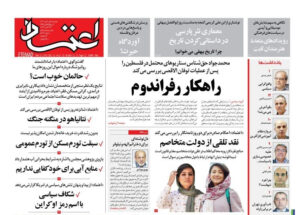It would be no exaggeration to assert that daily print newspapers in Iran have lost their significance on a grand scale. While there are no figures on circulation and finances, it’s hard to overlook that these newspapers fail to spark debates and that hardly anyone in the political discourse refers to them.
Under these circumstances, some eyewitnesses reported that the October 23rd edition of the Etemad newspaper was sold out in Tehran. The reason: The portrait of Elahe Mohammadi and Niloufar Hamedi on the front page. Following the verdict against the two journalists on October 22nd, Etemad was the only newspaper bold enough to publish it on the front page.
The entire propaganda machinery of the Islamic Republic has been propagating against Elahe Mohammadi and Niloufar Hamedi not only since the verdict. The peak was reached with several reports in state media and a “documentary” on the judiciary’s official news agency. Why the judiciary should have its own news agency is one of the questions rather not asked in the Iranian context.
Espionage certificates
According to the judiciary’s “documentation,” Elahe and Niloufar allegedly acted in the interest of the “enemy state,” based on the fact that they had attended workshops and programs on journalism “abroad,” – a keyword for “betrayal” in the language use of the Islamic Republic -, with the certificates presented as evidence of some sort of “espionage.” Seriously. And absurdly.
The report includes phone calls and chat and voice messages from the two with their friends, none of which, however, indicate any form of “collaboration” with any state. The fact that Hamedi spoke with the parents of Jina Mahsa Amini and Mohammadi reported on Jina’s funeral in a permitted newspaper, is labeled by the documentary (and consequently, the prosecutor and the judge) as evidence of “incitement to violence.”
Their efforts against gender-based violence are described as suppression of religious values, while this activism was supported by the former vice president.
According to Elahe Mohammadi’s sister, a newspaper vendor told her father, “Since the photograph of these two women is printed on the front page, everyone wants this newspaper today.” It’s remarkable how “these two women” have revived the newspaper in Iran, all from behind bars.



